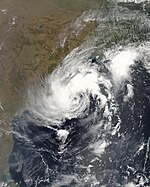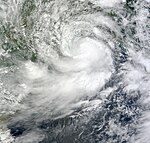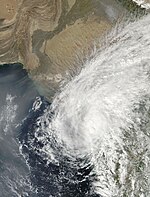Cyclone season in the North Indian 2009
 All the storms of the season | |
| Formation of the first storm |
April 14, 2009 |
|---|---|
| Dissolution of the last storm |
December 16, 2009 |
| Strongest storm | Aila - 968 hPa ( mbar ), 60 kn (110 km / h ) (3 minutes) |
| Deep Depression | 8th |
| Cyclonic storms | 4th |
| Severe cyclonic storms | 1 |
| Total number of victims | 343 direct, 2 indirect,> 500 missing persons |
| Total damage | $ 618.4 million (2009) |
|
North Indian cyclone seasons 2007 , 2008 , 2009 , 2010 , 2011 | |
The cyclone season in the North Indies 2009 had no official limits as is usual in other basins, but ran all year round. However, the tropical cyclones usually form in this basin between April and December, with the months before and after the monsoon season , i.e. April / May and October / November, being the most active. A tropical cyclone in the Indian Ocean is known as a cyclone .
The responsible Regional Specialized Meteorological Center (RSMC) is the India Meteorological Department in New Delhi . This gives a name to those tropical cyclones that have at least the status of a cyclone. Low pressure areas (depending on the wind speed depressions or deep depressions ) are numbered consecutively, with the letter combination BOB indicating that the system was formed in the Bay of Bengal . The letters ARB stand for the Arabian Sea .
The Joint Typhoon Warning Center (JTWC) in Honolulu issues separate warnings and forecasts for the US facilities in the Indian Ocean. The JTWC classifies according to the Saffir-Simpson hurricane wind scale , while the RSMC uses its own criteria for the classification, which are based, among other things, on the measurement of the continuous wind speed on the basis of a three-minute observation.
Storm names
Tropical cyclones in the Indian Ocean are named by the RSMC of the India Meteorological Department . The names are used only once each, so no devastating storm names are removed from the list of tropical cyclone names after the season ends .
- Bijli
- Aila
- Phyan
- Ward
- Laila (not taken)
- Bandu (not awarded)
- Phet (not awarded)
Storms
Cyclonic storm Bijli
| Cyclonic Storm ( IMD ) | |||
|---|---|---|---|
| Tropical storm | |||
|
|||
| Duration | April 14th - April 17th | ||
| intensity | 40 kn (75 km / h ) (3 minutes) , 996 hPa | ||
On April 13, an area of atmospheric convection with showers and thunderstorms over the central Bay of Bengal achieved slightly better organization. During the course of the day, a low pressure area forms under the convection, and weak rain bands also formed on the periphery of the system. On April 14th the convection deepened around the center of the circulation and accordingly the RSMC in New Delhi classified the system as Depression BOB 01 . Early the next day, the JTWC reported that the depression had intensified into tropical cyclone 01B . Due to a high pressure area over India , the storm moved in a west-northwest direction. That same morning, the RSMC upgraded the Depression to Deep Depression and at 15:00 UTC the RSMC upgraded the system to Cyclonic Storm Bijli. Storm warnings were issued for the four ports in Orissa , as the high surf threatened danger.
On April 16, the storm turned and migrated north-east parallel to India's east coast. At around 6:00 a.m. UTC on April 16, the storm reached its peak intensity with sustained three-minute winds of 75 km / h. Early the next day, RSMC New Delhi reported the weakening of Bijli into a deep depression that moved northwest and landed at Chittagong , Bangladesh . On April 18, the system over the mountains disintegrated.
Severe cyclonic storm Aila
| Severe cyclonic storm ( IMD ) | |||
|---|---|---|---|
| Category 1 cyclone | |||
|
|||
| Duration | May 23 - May 26 | ||
| intensity | 60 kn (110 km / h ) (3 minutes) , 968 hPa | ||
Late on May 21, the JTWC reported a tropical disturbance, the center of which was located about 515 nautical miles (around 955 km) south of the Indian city of Calcutta . The disturbance at that time consisted of a wide and poorly organized convection area south-east of the low-level circulation; this had consolidated into a circulation center in the twelve hours before. Because the system was embedded in an area with low vertical wind shear and the water surface in this area was warm enough, the low pressure area developed into a tropical cyclone. On May 22nd, the system was classified as Depression BOB 02 by the RSMC in New Delhi.
The center of the cyclone moved over the western Sundarbans and dispersed over land; however, Aila had the strength of a cyclone for almost 15 hours over land. This was favored that it was still partly above the river delta of the Ganges and near the coast to the Bay of Bengal. In the west of Bangladesh, the storm surge reached three meters according to media reports, the Sundarbans were flooded up to six meters, about two meters higher than the normal tidal range . The effects of the cyclone killed around 100 people, destroyed 61,000 homes and damaged more than 132,000 in the Indian states of West Bengal and Sikkim . The cyclone also had an impact in the state of Orissa . The heaviest rainfall was measured on May 25th in Paradip with around 260 mm. The storm was the first cyclone since 1989 to hit West Bengal in May. Cyclone Aila killed 175 people in Bangladesh.
Depression ARB 01
| Depression ( IMD ) | |||
|---|---|---|---|
|
|||
| Duration | June 23rd - June 24th | ||
| intensity | 25 kn (45 km / h ) (3 minutes) , 998 hPa | ||
Early on June 21, the JTWC reported that a depression formed about 675 km southwest of Mumbai . Multispectral recordings showed that the disturbance formed a circulation center close to the ground, convection and was in an environment with low vertical wind shear. The disorder developed and consolidated over the next two days. The RSMC New Delhi then determined on June 23 that the depression ARB 01 had formed and predicted an intensification of the system to a deep depression. This pre-landfall intensification did not take place, however, and by the afternoon of the day the system came overland to southern Gujarat . The well-developed low pressure area moved northeast and ends up in the Arabian Sea, where it intensified again into a depression. In the morning of June 26th, Depression ARB 01 resolved.
Unusually strong thunderstorms associated with the low pressure area killed at least nine people in the southern Indian state of Gujarat. More than 100mm of rainfall fell on Gujarat on June 23 before the landfall.
Depression ARB 02
| Depression ( IMD ) | |||
|---|---|---|---|
|
|||
| Duration | June 25th - June 26th | ||
| intensity | 25 kn (45 km / h ) (3 minutes) , 998 hPa | ||
Deep Depression BOB 03
| Deep Depression ( IMD ) | |||
|---|---|---|---|
|
|||
| Duration | July 20th - July 21st | ||
| intensity | 30 kn (55 km / h ) (3 minutes) , 988 hPa | ||
Early on July 20, the RSMC New Delhi discovered that the BOB 03 depression had formed around 120 km southeast of Digha in the Bay of Bengal. Convection had become steadily better organized and was in an area with light to moderate vertical wind shear. The depression continued to intensify and turned into deep depression that afternoon. Then the system crossed the coast on the border of the states of Orissa and West Bengal . The system continuously weakened overland.
Deep Depression BOB 04
| Deep Depression ( IMD ) | |||
|---|---|---|---|
| Tropical storm | |||
|
|||
| Duration | September 5th - September 7th | ||
| intensity | 30 kn (55 km / h ) (3 minutes) , 990 hPa | ||
In the early hours of September 3, the IMD determined that a low pressure area had formed within the monsoon channel off the coast of Orissa. The system evolved. The pronounced convection area began to consolidate around a center of circulation close to the ground within slight vertical wind shear. On September 5, the IMD reported the intensification of the low pressure area into a depression. In the course of the day the depression turned into a deep depression; according to the criteria of the JTWC, Zyklon 03B already reached wind speeds of a tropical storm. However, the JTWC did not continue to observe the storm because it was already moving across the country near Digha in West Bengal and, according to the forecasts, should already dissipate during the day. The IMD continued observing the system until September 7th. At that time the center of the now tiered system was over Jharkhand and the adjacent Chhattisgarh region .
In Digha, a person drowned after being carried away by the floods. The highest rainfall caused by the system was 76 mm.
Cyclonic storm Phyan
| Cyclonic Storm ( IMD ) | |||
|---|---|---|---|
| Tropical storm | |||
|
|||
| Duration | November 4th - November 11th | ||
| intensity | 45 kn (85 km / h ) (3 minutes) , 988 hPa | ||
Cyclonic Storm Phyan formed late on November 4th southwest of Colombo in Sri Lanka . The disturbance developed steadily over the next few days before reaching the south of the Indian subcontinent on November 7th. The fault crossed the mainland and reached the Arabian Sea late on November 8, where it intensified into the ARB 03 depression by November 9. The system swiveled to the northeast and after further intensification to the cyclonic storm, the system was named Phyan .
Cyclonic Storm Ward
| Cyclonic Storm ( IMD ) | |||
|---|---|---|---|
| Tropical storm | |||
|
|||
| Duration | December 10th - December 16th | ||
| intensity | 45 kn (85 km / h ) (3 minutes) , 996 hPa | ||
On December 10, the RSMC New Delhi announced that the BOB 05 depression had formed about 400 km east-southeast of Batticaloa , Sri Lanka. The system intensified into Cyclonic Storm Ward the following day. Ward wandered east of Sri Lanka for some time before the system landed as the Deep Depression near Trincomalee on December 14th.
Season overview

See also
- Atlantic hurricane season 2009
- Pacific hurricane season 2009
- 2009 Pacific Typhoon Season
- Cyclone seasons in the Southwest Indicator: 2008–2009 , 2009–2010
- Australian cyclone seasons: 2008–2009 , 2009–2010
- South Pacific Cyclone Seasons: 2008-2009 , 2009-2010
Individual evidence
- ^ Tropical Weather Outlook for the Northern Indian Ocean ( English ) RSMC New Delhi. April 13, 2009. Archived from the original on April 13, 2009. Retrieved on April 14, 2009.
- ^ Significant Tropical Weather Advisory for the Indian Ocean ( English ) Joint Typhoon Warning Center. April 13, 2009. Archived from the original on April 13, 2009. Retrieved on April 14, 2009.
- ^ Significant Tropical Weather Outlook for the Indian Ocean ( English ) Joint Typhoon Warning Center. April 14, 2009. Archived from the original on April 14, 2009. Retrieved on April 14, 2009.
- ↑ depression over southeast and adjoining central Bay of Bengal ( English ) RSMC New Delhi. April 14, 2009. Archived from the original on April 14, 2009. Retrieved on April 14, 2009.
- ↑ Tropical Cyclone 01B (One) Advisory No. 001 ( English ) Joint Typhoon Warning Center. April 15, 2009. Archived from the original on April 15, 2009. Retrieved on April 15, 2009.
- ^ Deep depression over central & adjoining southeast Bay of Bengal: - Pre cyclone watch ( English ) RSMC New Delhi. April 15, 2009. Archived from the original on April 15, 2009. Retrieved on April 15, 2009.
- ↑ Tropical Storm Bijli Advisory No. One ( English ) RSMC New Delhi. April 15, 2009. Archived from the original on April 15, 2009. Retrieved on April 15, 2009.
- ↑ Cyclone Bijli alert along Orissa coast ( English ) Sindh Today . April 15, 2009. Archived from the original on April 17, 2009. Retrieved on April 15, 2009.
- ↑ Tropical Cyclone 01B (Bijli) Advisory No. 006 ( English ) Joint Typhoon Warning Center . April 16, 2009. Archived from the original on April 16, 2009. Retrieved on April 17, 2009.
- ↑ Tropical Storm Bijli Advisory No. Six ( English ) India Meteorological Department . April 16, 2009. Archived from the original on April 16, 2009. Retrieved on April 17, 2009.
- ↑ Cyclonic storm 'Bijli' ( English ) India Meteorological Department . April 17, 2009. Archived from the original on April 17, 2009. Retrieved on April 17, 2009.
- ^ A b Significant Tropical Weather Advisory for the Indian Ocean 2009-05-21 18z . Joint Typhoon Warning Center . May 21, 2009. Archived from the original on May 21, 2009. Retrieved on May 23, 2009.
- ↑ Regional Specialized Meteorological Center: Severe Cyclonic Storm, AILA: A Preliminary Report ( English , PDF, 3.61 MB) India Meteorological Department. June 2009. Archived from the original on June 23, 2009. Retrieved June 23, 2009.
- ↑ Lightning claims eight lives in Gujarat ( English ) The Hindu. June 24, 2009. Archived from the original on November 4, 2012. Retrieved on June 24, 2009.
- ^ Nine killed by lightning strikes across state ( English ) Indian Express. June 24, 2009. Retrieved June 24, 2009.
- ↑ Downpour at Gujarat's doorstep ( English ) DNA. June 24, 2009. Retrieved June 24, 2009.
- ↑ Shipping Bulletin for Met area VIII 2009-09-03 0900 UTC ( English ) India Meteorological Department . September 3, 2009. Archived from the original on September 4, 2009. Retrieved on September 5, 2009.
- ↑ Shipping Bulletin for Met area VIII 2009-09-03 1000 UTC ( English ) India Meteorological Department . September 3, 2009. Archived from the original on September 4, 2009. Retrieved on September 5, 2009.
- ^ Significant Tropical Weather Advisory for the Indian Ocean 2009-09-04 12z ( English ) Joint Typhoon Warning Center . September 4, 2009. Retrieved September 5, 2009. ( Page no longer available , search in web archives )
- ↑ Special Tropical Weather Outlook 2009-09-05 03z ( English ) India Meteorological Department . September 5, 2009. Archived from the original on September 5, 2009. Retrieved on September 5, 2009.
- ↑ Special Tropical Weather Outlook 2009-09-05 06z ( English ) India Meteorological Department . September 5, 2009. Archived from the original on September 5, 2009. Retrieved on September 5, 2009.
- ^ A b Tropical Cyclone Warning 2009-09-05 09z ( English ) Joint Typhoon Warning Center . September 5, 2009. Archived from the original on September 5, 2009. Retrieved on September 5, 2009.
- ↑ IMD: C-Wind Advisory 2009-09-05 12z ( English ) India Meteorological Department . September 5, 2009. Archived from the original on September 5, 2009. Retrieved on September 5, 2009.
- ↑ Depression passes by ( English ) The Telegraph. September 6, 2009. Retrieved September 6, 2009.
- ↑ depression over southwest and adjoining southeast Bay of Bengal ( English ) RSMC New Delhi. December 10, 2009. Archived from the original on December 10, 2009. Retrieved on December 21, 2009.
- ^ Cyclonic storm WARD over the southwest and adjoining southeast Bay of Bengal ( English ) RSMC New Delhi. December 11, 2009. Archived from the original on December 11, 2009. Retrieved on December 11, 2009.
- ↑ Deep depression crossed Sri Lanka coast near Trincomalee ( English ) RSMC New Delhi. December 14, 2009. Archived from the original on December 14, 2009. Retrieved on December 14, 2009.















